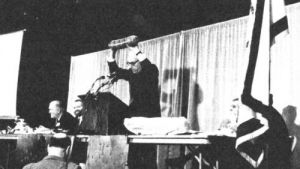Introduction
Speaking to a crowd of thousands of miners at a rally in Charleston, W.Va., in 1969, Congressman Ken Hechler summarized the coal industry’s reaction to the scourge of black lung:
Now the coal operators and some doctors who seem to be close to the coal operators say that there is no such thing as black lung, or if there is, maybe it won’t hurt you. But if it does hurt you, we’d better not compensate you for it.
But in case we do compensate you for it, we had better study this subject scientifically. We’d better refer this whole question to an impartial board of other coal company doctors. Then we’ll study it for five, or 10 or 15 years, and by that time either the problem will go away or your lungs will go away.
Hechler’s words, uttered 44 years ago, bluntly articulate a strategy that began more than a century ago and continues today.

Despite widespread reports of a unique disease afflicting coal miners dating to the 19th Century, the industry and the doctors it employed succeeded in stifling a comprehensive law to recognize black lung and compensate those left breathless by it until 1969.
Much the same approach that hampered initial recognition of the disease has been used more recently to limit the range of illnesses that fall under the broad term “black lung.” Each expansion to recognize the varied forms of lung destruction induced by dust has come only after a protracted fight.
For most of the first three decades of the 20th Century, the industry maintained that coal dust was harmless, and coal-friendly doctors produced studies suggesting it protected miners from tuberculosis. As evidence of miners’ illnesses mounted in the 1930s and 1940s, the industry claimed that silica — the toxic mineral present in much rock in mines — was the sole cause of disease, making it almost impossible for most coal miners to prove their claims of work-related disability.
In the 1950s and 1960s, when compelling evidence emerged that coal dust also could cause disease, the industry argued that only the most advanced form — complicated coal workers’ pneumoconiosis — caused breathing problems.
In the 1990s, the industry fought attempts to include diseases such as emphysema and chronic bronchitis in the definition of black lung, ultimately losing in 2000 when the Labor Department issued rules recognizing these illnesses’ potential connection to coal dust. The industry also has been forced to accept research showing that even earlier stages of the classic form of the disease can impair miners’ breathing.
Now the latest iteration of this struggle is playing out.
In much the same way that silica and smoking have been blamed in past fights, the culprit this time is a rare disease called idiopathic pulmonary fibrosis, IPF, according to the industry. The cause of this disease is unknown, company doctors say, but it definitely isn’t coal dust.
Once more, today’s miners face the strategy of denial and containment that led Pennsylvania State University professor Alan Derickson, in a 1998 book on the history of black lung, to call the nation’s response to the disease “a public health disaster.”
Read more in Environment
Breathless and Burdened
Senators push reform of black lung program that ‘failed’ sick miners
IMPACT: Citing a Center-ABC investigation, senator says government has ‘abiding obligation to right this wrong’
Breathless and Burdened
Johns Hopkins suspends black lung program after Center-ABC investigation
IMPACT: Prestigious hospital will review X-ray reading service.


Join the conversation
Show Comments